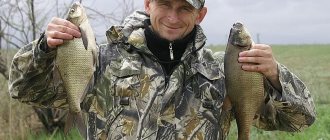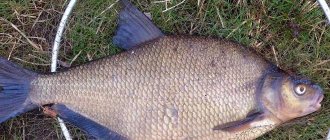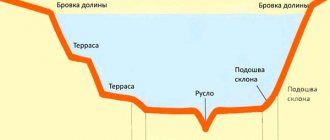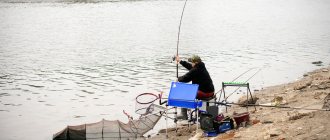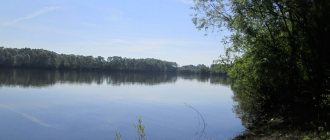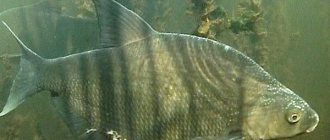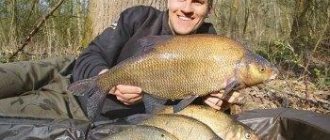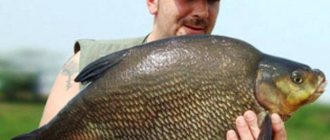Bream is a type of river fish that, thanks to its well-developed senses of smell and touch, can find food both in poor visibility and in complete darkness.
Large bream are very cautious, so they mainly go out in search of food at night, and practically do not move during the day. Moreover, it is at night that there is a greater likelihood of finding something to eat, since bottom organisms are especially active at this time, which makes them more visible to fish.
Choosing the right place to catch bream
Breams know in which places the most organisms suitable for feeding live, so as soon as dusk or even night falls, they gather in a flock and go for food. In rare cases, this happens in the early morning. During the day, bream rarely moves; it usually spends this time in holes where the current is calm. Most aquatic organisms: crustaceans, worms and all kinds of nymphs most often accumulate on the stem and roots of algae, as well as on the eroded roots of bushes or trees. Therefore, you need to catch bream with a fishing rod and half-bottom at night near a steep, washed-out bank overgrown with bushes and grass. Before fishing, this place must be prepared.
But, nevertheless, bream in search of food can also go to shallow rocky ridges, which are located near the depths of the riverbed. In such cases, bottom tackle is used for fishing for bream. After all, it can be thrown to a greater distance from the shore.
At night, when the bream walks underwater and looks for food, it travels quite a long distance. If he knows exactly where a large amount of food is located, he can swim almost 1000 meters to this place.
In order to understand where the bream will be at night, you need to take into account the depth of the river, as well as the topography and structure of the bottom. Quite often it happens that bream finds food below the place where the breaker stream washes the algae. You also need to pay attention to places with a large accumulation of large stones, since there may be food carried by the current stuck between the stones. Bream can also be found in places where the fast flow of water slows down sharply, because there remains food that was carried by the current. On rivers, such areas should be looked for behind capes, channels or dams. In these places there are almost always quiet water reaches. As a rule, in places where a wide channel flows into a narrow one, and vice versa, whirlpools or reverse currents appear. This is where bream most often comes to feed, since this is the border between fast and slow currents.
Tackle and feeder for bream
Two feeders. We are not talking about sport fishing, competitions, frantic pace. We write about soulful night fishing, where a bite is already an event! Two feeders are needed for the far and near edge .
We advise you not to feed both points. This way you will smear the bait table. Feed the far edge, and at the nearest point the baited hook will lie in wait for the night bream, which has decided to move closer to the shore.
For the far point, use a 4.2 meter long feeder with a casting of up to 150 grams, and for the near point, a 3.6 meter feeder with a casting of up to 90 grams is suitable.
We recommend using braided wire. With all the advantages of a braided cord, it is worth considering that it does not stretch. This can play a cruel joke when large fish are actively jerking. A properly adjusted reel clutch and 7 cm of feeder rubber will save the situation.
If we talk about installation, then of course - paternoster. Place a piece of feederham between the shoulder of the paternoster and the leash. It will absorb the jerks of the fish. Using an installation with an anti-twist tube is justified in places where there are a lot of shells. The tube will prevent abrasion.
Interesting on the topic: How to choose a feeder rod. Feeder test
Fishing rod equipment for bream fishing
For fishing, an angler usually clears a suitable place on the shore from vegetation. At the same time, it creates a spacious platform and seating area. The bank is strengthened with special stakes, which are entwined with vines. This is necessary in order to prevent a collapse. Along the edge of the platform, holders for fishing rods are driven into the ground. When fishing for bream, it is recommended to use 3-5 rods at the same time. This will allow the fish to quickly find the bait among the underwater food.
At a depth of 2 to 4 meters near the shore, the rod should be 4-6 meters long. The equipment can be chosen either fixed or movable. If it is still a moving equipment, then a spinning reel with a small spool is recommended. When casting a fishing line, the line should be one and a half meters longer than the rod. The main fishing line should be monofilament with a diameter of 0.22-0.3 mm. The required leash should be 20-35 cm long, a little longer in strong currents. It should be secured using a swivel and a carabiner, which is necessary for quickly changing leashes. The size of the required hooks should be no less than No. 4 and no more than No. 12, it all depends on the size of the fish that bites in a given place. It will be difficult to catch a bream with very large hooks. Accordingly, it will be difficult to catch a large bream with a small hook.
Since the feeding area of river bream is always on the current, it is recommended to use a “lollipop” float to catch it. After all, it can withstand fast currents well. To load in this case, you need to take a sliding sinker; an olive is perfect. At the top of the float there should be a mount for a phosphorescent firefly.
Equipment for night fishing for bream in the current is shown in the figure:
☸ Parking arrangement
Night fishing for bream in winter requires careful preparation. It can take a long time before the first bite, and you need to spend it in a comfortable environment. First, the required number of holes are drilled at the selected location (usually three or four), after which you can begin setting up the tent, always with the back side facing the wind. This way it will remain stable even with strong gusts.
The skirt of the tent should be sprinkled with snow and trampled down well - this will further increase its wind resistance and ensure proper thermal insulation. For heating, you can use a variety of heat sources, from a paraffin candle to a gas stove. True, you cannot use them all the time, since in a confined space an open flame quickly “eats” oxygen. You also need to take care of the lighting of the tent. It is better if the lantern is fixed at the top and in the middle. At the final stage, you need to conveniently arrange all the fishing accessories inside: place the box opposite the holes, put a box with bait on the left, a hook on the right, and so on.
Half-bottom rig for bream fishing
The half-bottom is different in that it can be used to catch fish without the use of special floats. To do this, it is necessary to position the half-bottom rod so that a regular float or a bite alarm, located closer to the top, causes the fishing line to sag due to its weight. Thus, by the vibration of the float it will be possible to determine the bite.
To catch bream at night, it would be a good idea to use several half-bottoms at once. Their equipment, like that of fishing rods, can be both deaf and movable. The rod and reel also matches the bream fishing rod.
The lower part of the rig should consist of the following components: weight, leash, carabiner, swivel and hook. Their size and other parameters also remain unchanged.
Despite all the above-mentioned similarities between the poldonka and the fishing rod, the pludonka still has one advantage. With its help it is much faster and easier to catch bream at different distances from the shore. But if you fish with a “lollipop” float, then you need to measure the depth each time in order to set the float at the desired level.
Night fishing for bream on a feeder
Apparently, the night bream finally started biting this year too. Catching night bream on a feeder.
Uncharacteristically high temperatures have had a major impact on fish behavior this summer. The night bite of bream, usual for this time of year, still won’t start. Apparently, seasonal fish migrations were disrupted due to warm winters and hot summers. Since in my case a fishing trip for a day, unfortunately, is only possible once a week, on the day off after night duty, I decided to go out for night fishing, in the hope of a night bite. For this I went to the river. The rocky shore did not allow setting up a fishing spot directly on the shore, so it had to be moved to the edge of the water surface. Fortunately, a feeder chair with telescopic legs was ideal for this purpose.
My tool was a 10-foot-long medium feeder with a two-ounce tip. I was going to fish with one rod, so as not to get confused at night and not rush to pay attention to the gear.
Having set out the chair and laid out the contents of the fishing box on the stones next to it, I mixed a bag of bream bait with the addition of boiled peas.
While the bait was saturated with water, I hastily marked the bottom. The starting point was the transition from small stones to large ones. The clip on the reel was placed at a distance of two meters from large stones. A bright lantern was chosen as a landmark on the opposite bank, clearly dividing the bank into two equal parts. Having sprinkled the bait with water, bringing it to the desired consistency, I began the starting feeding. Fifteen feeders with bait were sent to the point, after which I cut the oparium and made the first cast with a leash.
It makes no sense to use thin leashes for night fishing, so I tied a leash made of 0.16 monofilament with a number ten hook. A bunch of maggots soaked in vanilla dip was threaded onto the hook. All that was left was to wait for the bite.
Periodic recasts to the bright point of the lantern, which served as a guide, did not bring results. The first bite occurred after midnight. The tense quivertype acted out. The cutting was late and therefore ineffective. The hook turned out to be empty. Trying not to miss the bite, I put my hand on the rod blank and froze in anticipation. Playing the quiver again, but this time with an instant hook. Here he is the first handsome man of the night. The half-kilogram undergrowth is pulled up to the chair leg with virtually no resistance.
Pulling it over the coastal rocks is not at all easy. You can easily lose fish there. Soft bream lips are easily cut with a thin hook. We have to collect the landing net. The next bite shows the timeliness of the decision made. Long-term fishing, jerks smoothed out by the feedergam, and then another underbreed falls off the hook in the landing net.
The cord is heavily smeared with mucus, which means that a bream is spinning on the bait spot. Timid pokes and again acting out the quivertype. This time, a slightly larger fish sat securely behind the lower lip, almost swallowing it.
You have to remove the hook using an extractor. Competition makes people take the bait more greedily. The bites continue until half past five in the morning. During this time, about a dozen bream were caught. The largest is a kilo-sized silver beauty . But in the morning the wind changes, and with dawn the point ceases to please with bites.
At six o'clock I put the contents of the box, collect the feeder and carry the gear to the shore over the stones. Quite a normal catch for night fishing.
Apparently, the night bream finally started biting this year too. NHNCH.
Pike spinner
Balancer Kuusamo Tasapaino X-PRO Kuha
In wet snowfall, in the middle of winter
Lure
Any convenient container is quite suitable for preparing bait. To do this, you can take bait purchased at a specialized fishing store, mix it in equal quantities with boiled pearl barley or wheat and add a little baby oatmeal to the resulting mixture. The amount of oatmeal determines how quickly the lump of bait will erode. The more oatmeal, the longer this process will take. You can also include boiled peas in the bait for bream. Because it has a smell that can spread far. If you have maggots, then you also need to send them to the bait. This will make it more attractive to fish, since these white worms tend to move, the lump of bait will collapse faster, and particles that attract fish will begin to come off from it. In addition, at night, fish can feel even the slightest vibrations that come from living organisms in the water and quickly approach the right place. The ratio of all ingredients included in the bait depends on the flow speed and is determined experimentally.
If fishing is planned for the night, then bait the fish in the evening. Balls with a diameter of 3-4 cm are molded from the bait and sent into the water. Their initial quantity is 20-30 pieces. At night, when the fishing itself begins, it is no longer advisable to throw balls from the mixture, since the bream will hear extraneous movement and leave. Of course, if there is no bite for a long time, you can feed the area a little, but this must be done with extreme caution and in very measured doses. Throw only 3-5 bait balls into the water.
Bream, which lives in most Central Russian rivers, requires longer feeding. To do this, many fishermen in places where bream are found lay out bait in advance, which can consist of boiled pearl barley or wheat. Every evening, 1 kg of it is thrown into the water.
Also, in places where bream are found, many fishermen prefer to place loaded mesh feeders, which are filled with dry bread. The bread becomes soggy and spreads along the river in the form of crumbs. This path of food attracts bream. This type of feeder must be installed from a boat. In order not to lose the place where the feeder is located, there is a buoy on it. It is a piece of foam plastic painted in a discreet color. The installation location is chosen slightly higher than the place where the fisherman sits, this will allow you not to cling to the fishing line while casting. You also need to know that the presence of locks on some rivers may affect the bite. For example, on Pakhra there is a small current and closed sluices, so bream may bite poorly there at night. But if the current were normal, the bream would actively move along the riverbed in search of feeding.
Features of night fishing in winter
In winter, fishing for bream in the dark has its own characteristics. When fishing at night, the fisherman usually drills 2-3 holes located next to each other. This allows you to fish with several gears at the same time.
Fishing with winter fishing rods and a float
Since the food activity of the fish is at a low level, it is advisable to feed the holes a couple of hours before the start of fishing. Night bream in winter reacts better to mixtures with a high content of animal components. The bite largely depends on how many bloodworms or maggots were added to the bait.
In the evening, a winter tent is set up on the feeding holes. Next, the fisherman lights a lantern or candles and begins to prepare his fishing rods.
In night ice fishing, float gear equipped with a hook and sinker is more often used. When fishing stationary, “devils” and other jigs work much worse. They often catch small underbreeders. A bunch of bloodworms is used as bait.
The night fish bite in winter begins around eleven in the evening and continues until five in the morning. Additional feeding of the holes should not be done, as this will certainly frighten the approaching flock.
When fishing, you must have a hook with you. This tool will help you pull a large bream out of the hole.
Bite time
At night, bream emerges briefly from cover in search of food. Therefore, the most active biting occurs precisely at this time. And it falls on the period from 23:00 to 2:00 am. If shortly before your fishing there was a flood that made the water cloudy, or rain that made the water very cold, then the active time for bream can begin as early as 21:00-22:00. This is due to the fact that the above circumstances do not allow the fish to fully feed. Subsequently, the hungry bream goes out in search of food earlier than its usual time. Often during these periods, bream can bite until the early morning, then quiet down a little and recover between 8:00 and 10:00.
Often, when the bream approaches, the rest of the fish stop biting altogether. This is due to the fact that fish have special olfactory abilities, and they easily recognize their relatives by the properties of mucus. In addition, this feature allows fish to notice the slightest changes in the chemical composition of the water. Often this is the reason for the complete absence of a bite after the water level in the reservoir rises.
Features of the fishing process
Feeding should begin before dark with several feeders. It is recommended to use larger cages. Bream are active at night, so the smallest fish will be collected first to feed. The frequency of casting in the daytime is about 8 minutes. At night, the frequency is reduced to 30 minutes.
If there is no intense bite, you should periodically twitch the rod. This will make the baits move and provoke the bream to actively hunt. Often large specimens bite very weakly and uncertainly. It’s worth keeping a close eye on the tip so as not to miss a bite.
Strong resistance is exerted either by young individuals or those who have swallowed the hook. Morning fishing is ineffective. The bream goes to the depths, where it remains passively until the heat drops and dusk sets in. For the morning, long-distance casts into holes at the bottom of the reservoir are suitable.
Disadvantages and advantages of night fishing
The advantage of night fishing is the almost complete absence of small things that interfere with successful fishing. Small perch and bleak stop attacking the feeder. And large bream, careless while searching for food, bite actively and often. Insufficient visibility in the water reduces the chance of spooking fish with the shine of gear.
Another advantage is that bream, in search of food, approaches the shores and is mainly found in shallow water. The disadvantages stem from the same advantages. Insufficient lighting makes it difficult to monitor the bite, and full-time wakefulness is accompanied by increased lethargy.
Required equipment and supplies
One of the most necessary accessories for night fishing is a flashlight. If you plan to catch bream close to the shore, then the light should not fall on the water. Therefore, for such fishing it is necessary to take a small headlamp, with the help of which it will be very convenient to bait the hook. To detect a bite, you do not need a flashlight; to do this, it is enough to equip the float with a luminous “pilot” or a phosphorescent sticker.
For bait and spare accessories needed for fishing, it is best to choose boxes that will be very easy to open. Place these boxes while fishing on a specially equipped area behind bushes or grass. If there is no vegetation at all on the shore, it is necessary to install some kind of protection from light entering the water. When the protection is very reliable, you can even use a rechargeable bat-type flashlight. Also, just in case when fishing, you should always have a spare flashlight.
Even when fishing, you need to have wire cutters, scissors and pliers so that if something happens you can trim the ends of the leashes, remove excess lead or bend the hook.
The landing net and cage for bream fishing should be spacious. The cage should be made of a soft mesh that will not injure the caught fish. They lower it into the water a little far from the fishing spot so that the caught fish does not scare away the free-roaming ones.
How to choose a place
At night, you can successfully fish in various types of reservoirs:
- lakes;
- reservoirs;
- medium and large rivers.
Night fishing for bream will be successful only if the fishing point is chosen correctly. In the summer, after sunset, the fish swim to feed:
- in shallow waters located near a hole or channel edge;
- to steep, clayey banks;
- into overgrown bays with a depth of up to 2 m;
- to the riffles.
When choosing a place, you need to pay attention to the fact that next to the shallow-water zone there is a deep-water area where the fish stand during daylight hours.
In winter, when darkness falls, you should look for bream at the exits of the pits. Schools of fish can also be found in areas with a depth of 5–8 m located near the river bed.
Summer night fishing for bream
Bream, like any other fish, has well-developed senses of touch and perception, which gives it the ability to navigate well and capture odors well in conditions with limited visibility and at night. Therefore, fishing for bream at night in summer
can be very effective.
After all, it is at night that the largest bream prefers to feed, famous for its caution and during the daytime it once again does not want to leave its shelter. Night fishing spots
Perhaps the most successful places for catching bream can be places where a large number of different bottom organisms accumulate. Schools of bream go to such places to feed in the evening and morning dawn. However, at night, bream constantly visits these places. These are the places where you catch bream at night
happens to be the most effective.
During the daytime, bream show little activity. They prefer to rest in deep holes in places where the current is relatively calm. It is known that the largest variety of small aquatic life can be found in the rhizomes of bushes and trees washed away by water, as well as on the roots and stems of aquatic vegetation. Therefore, for night fishing for bream using float gear or donka, it is better to choose a steep, overgrown bank washed away by water. However, there you will need to first prepare a place for night bream fishing.
had good prospects.
In addition, bream can often move at night from the depths to shallow waters with rocky ridges, which are located next to channel dumps in depth. In such places it is better to use bottom gear, which can be cast a considerable distance from the shoreline. In the process of moving from daytime stopover sites to feeding sites, bream can cover quite long distances. Knowledge of the depths and topography of the bottom of the reservoir where night fishing for bream
.
You also need to pay attention to places where strong currents may slow down. In such places, the flow of water brings a lot of various food, which then settles there. Such places arise behind channels, dams or capes, and there are almost always calm reaches there. You can also look for bream on the borders between slow and strong currents.
Night fishing for bream with a fishing rod
For night fishing, it is advisable to prepare the place in advance. This should be a spacious area with shores reinforced with stakes and vines. This is done to prevent the soil from collapsing into the water. Closer to the water, special holders for fishing rods or slingshots are stuck into the ground. It is recommended to place 3-5 fishing rods in such a place. In this case, when a school of bream approaches the fishing point, the fish will be able to quickly find the bait among the bait located at the bottom.
If fishing for bream at night
occurs close to the shore and the depths at the fishing site are small (less than 4 m), then it is better to use fishing rods with a length of 5-6 m with movable or blind equipment. As a base, it is better to use monofilament with a diameter of 0.24-0.28 mm. The length of the leash can vary between 25-50 cm. In strong currents, the leash should have a maximum length, in weak currents it should be closer to the minimum values. The sizes of hooks can be different, it all depends on the size of the intended prey.
If we take into account that on rivers bream prefers to feed in places where there is a fairly strong current, then experts recommend equipping the equipment with a “lollipop” float and a sliding weight. The lollipop shaped float works great in a fast stream. The top of the float must have a mount where you can attach a phosphorescent firefly.
(Fig. 1) Equipment for catching bream at night: 1 – firefly; 2 – fastener for firefly; 3 – cambrics; 4 – olive weight; 5 – stopper pellet; 6 – swivel for connecting the leash and the base
Night fishing for bream on a half-bottom
Night fishing for bream on a half-bottom in summer
It is notable for the fact that it makes it possible to fish without using a special float.
In this case, the fishing rod is placed on a stand so that a regular float, moved to the tip of the fishing rod, can create slack in the fishing line. In this case, the bite is monitored by the vibrations of the float. When fishing for bream at night, it is recommended to use several half-bottoms. The half-bottom can have both sliding and blind rigs. This tackle is practically no different from the float rod mentioned earlier. The advantages of a half-bottom are that fishing for bream at night
at different distances from the shore will be much easier. If, for example, you are fishing with gear that has a lollipop float, then in order to clearly establish the level of the float you will need to constantly measure the depths at the fishing point.
How to feed a place where you catch bream at night
Usually, purchased bait for catching bream “Sabaneev” or “Red Fighter” is mixed in equal quantities with steamed pearl barley or wheat and a little baby oatmeal is thrown in there to strengthen the bait balls. Some fishermen also add steamed peas, which perfectly distributes the smell over long distances. In a word, recipes can be different.
For successful night fishing for bream, the fishing point must be fed the night before. Form bait balls the size of a tangerine and throw 20-25 pieces into the fishing spot. But during night fishing, bait is no longer thrown in. If there is no bite for a long time, you can throw a few more balls at the desired point. It’s also a good idea to throw bait into the fishing spots.
Typically, the bait can be steamed peas or wheat. Late in the evening, such bait (weighing about 1 kilo) is sent to the fishing point every day. You can send bait there in special mesh feeders. In this case, the feeders are filled with crackers. When they get wet, the current will wash them out of the feeders, and they will create a trail that is attractive to bream.
When does the night bream bite?
At night, bream feeding does not last too long, 3-4 hours. The most active night fishing for bream occurs from eleven o'clock at night to two o'clock. If for some reason the bream was not able to feed actively, then the night feeding time can begin earlier, for example from nine in the evening. In such situations, bream can bite with varying degrees of activity until the morning. Then its activity drops around 6 am and only at 8 am it resumes again and lasts until 10 or 10.30 am.
Usually, if a large bream approaches, the other fish immediately stops biting and gives way to it.
What do you need for night fishing?
A flashlight is a very important element of night fishing. It is best to use a browband when changing the bait on the hooks. It is highly undesirable for light to shine on the water. In addition to a flashlight, the fisherman must have pliers, a knife, a catch cage and a landing net for removing prey from the water.
Fishing for bream at night
will give you the opportunity not only to catch a real trophy, but at the same time to enjoy the silence of the night and nature, to feel the real romance of night fishing.
